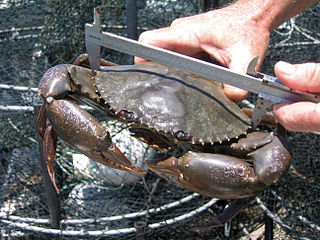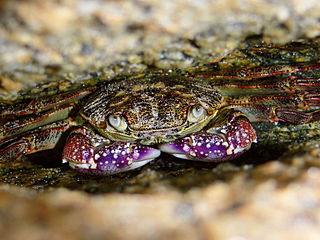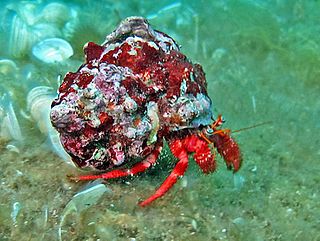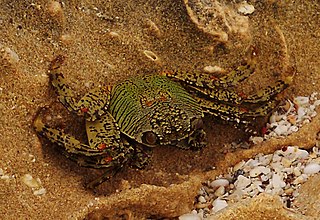
Scylla serrata is an ecologically important species of crab found in the estuaries and mangroves of Africa, Australia, and Asia. In their most common forms, their shell colours vary from a deep, mottled green to very dark brown.

The halloween hermit crab, also known as the striped hermit crab or orange-legged hermit crab, is a brightly colored aquatic hermit crab of the family Diogenidae. Besides its ability to routinely clean algae in aquaria, the halloween hermit crab's festive striped coloration also appeals to enthusiasts; it is considered the most brightly colored hermit crab in normal aquarium use.

Grapsus grapsus is one of the most common crabs along the western coast of the Americas. It is known as the red rock crab, or, along with other crabs such as Percnon gibbesi, as the Sally Lightfoot crab.

Hemigrapsus sexdentatus, also called the “common rock crab” or “common shore crab,” is a marine crab indigenous to the southern shores of New Zealand. This crab is a member of the Varunidae family in the order Decapoda.

The Smooth Shore Crab is a marine large-eyed crab of the family Grapsidae, found in New Zealand and the Juan Fernández Islands of Chile.

Leptograpsus variegatus, known as the purple rock crab, is a marine large-eyed crab of the family Grapsidae, found in southern subtropical Indo-Pacific Oceans. It grows to around 50 millimetres (2.0 in) shell width. It is the only species in the genus Leptograpsus.

Charybdis is a genus of swimming crabs in the family Portunidae. It is named after the monster Charybdis of Greek mythology.

Plagusia squamosa is a marine crab of the family Plagusiidae, formerly considered a subspecies of Plagusia depressa. It is found in tropical Indo-Pacific oceans. P. squamosa's carapace is bumpy and quite coarse, seemingly scaly, leading to its common name: The Scaly Rock Crab.

Percnon gibbesi is a species of crab. It is one of at least two species commonly called Sally Lightfoot, and is also referred to as the nimble spray crab or urchin crab. It has been described as "the most invasive decapod species to enter the Mediterranean".

Pachygrapsus marmoratus is a species of crab, sometimes called the marbled rock crab or marbled crab, which lives in the Black Sea, the Mediterranean Sea and parts of the Atlantic Ocean. It is dark violet brown, with yellow marbling, and with a body up to 36 millimetres (1.4 in) long. A semiterrestrial omnivore, it feeds on algae and various animals including mussels and limpets.

Dardanus pedunculatus, commonly referred to as the anemone hermit crab, is a species of hermit crab from the Indo-Pacific region. It lives at depths of up to 27 m and collects sea anemones to place on its shell for defence.

Carpilius maculatus, common names seven-eleven crab, spotted reef crab, dark-finger coral crab, and large spotted crab, is a species of crab in the family Carpiliidae, which also includes C. convexus and C. corallinus. While there have reports of the C. maculatus as being poisonous, biochemical testing has revealed that they lack any paralytic shellfish toxins.
Lauridromia intermedia is a species of crab in the family Dromiidae and is native to the western Indo-Pacific. It often carries a piece of sponge on its back by way of camouflage, and one individual was found carrying a sea anemone in a similar manner.

Dardanus arrosor, the red reef hermit or Mediterranean hermit crab, is a species of hermit crab.

Geograpsus lividus is a species of crab in the family Grapsidae. Little research has been conducted on this species. It was originally classified as belonging to the genus Grapsus; however, this name is no longer used.

Charybdis natator, the ridged swimming crab, wrinkled swimming crab or rock crab, is a widespread Indo-Pacific species of swimming crab from the genus Charybdis. It gets its name from the ridges on the dorsal surface of the carapace. It is a crab species which is of minor importance in fisheries.
Cembalea triloris is a species of jumping spider in the genus Cembalea that lives in Namibia and South Africa. It was first described in 2011 by Wanda Wesołowska and Charles Haddad. The spider gets its name from the existence of three distinctive white stripes on its back, more noticeable on the male. The spider is small, with a dark brown carapace that is between 2 and 2.3 mm long and a lighter sandy or yellowish-white abdomen that is between 2.4 and 2.6 mm long. It has a large eye field and a clypeus that extends to the edge of the carapace. It can also be distinguished from other members of the genus by the large spike that protrudes from the abdomen and the male's long embolus.

Grapsus albolineatus is a species of decapod crustacean in the family Grapsidae, native to the Indo-Pacific.
Diphya wesolowskae is a species of long-jawed orb weaver in the genus Diphya that lives in South Africa. First described in 2020 by Mikhail Omelko, Yuri Marusik and Robin Lyle, the spider is small, with a typical length between 2.8 and 3.17 mm. The female is larger than the male. It has a brown to dark brown and patternless carapace, which distinguishes the species from the more common Diphya simoni. The male has an abdomen that is also brown to dark brown and has a pattern of two dark spots, although some examples have more complex, but indistinct, patterns of spots and stripes. The female has a light brown abdomen marked with large spots and stripes. The copulatory organs are distinctive to the species. The female has a epigyne that lacks pockets but has a thicker septal stem than Diphya foordi, and the male has a very long, thin projection that extends from the palpal bulb beyond the cymbium and a very short embolus.
















